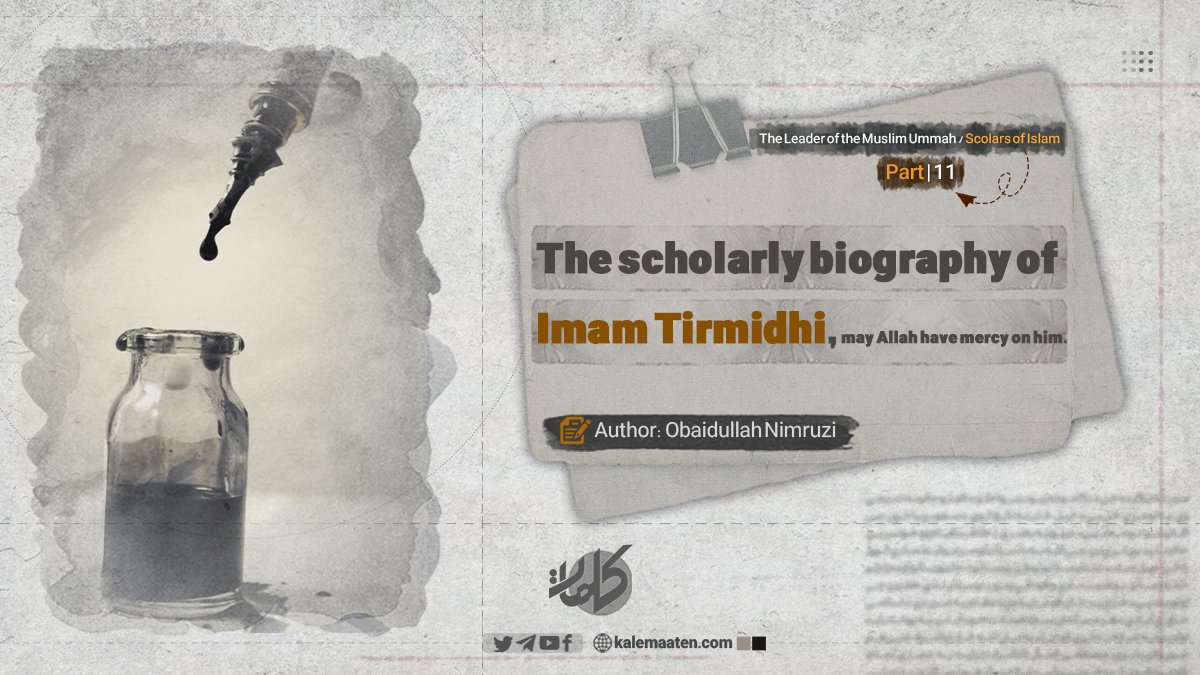
Author: Obaidullah Nimruzi
The Scholarly Biography of Imam Tirmidhi ‘May Allah Have Mercy on Him’ (Part 11)
Preface:
In previous sections, we discussed the scholarly legacy of Imam Tirmidhi and examined his illustrious status among the Imams of Hadith. However, a profound and comprehensive understanding of those discussions necessitates delving into a domain that serves as the foundation and strong pillars of the science of Hadith. Without grasping these principles and fundamentals, our efforts to analyze the personality and works of scholars like Imam Tirmidhi would be akin to building a structure on a shaky foundation.
Such discussions are not merely simple introductions; they are essential and vital, as they form the link between recognizing the rank of Hadith scholars and understanding the significance of their scientific contributions. Just as every field of knowledge requires preliminary definitions and terminologies as keys to entering its core, understanding these concepts in the science of Hadith is a prerequisite for comprehending the essence of this luminous discipline and appreciating the stature of its carriers.
For a tangible analogy, consider this: Just as one cannot comprehend the works and sayings of a nation’s great figures without understanding their language and literature, one cannot truly grasp the status of narrators and Hadith scholars without understanding the foundations and terminologies of the science of Hadith.
Summary of Discussions:
1. Definition of Hadith
– Linguistic Perspective: Hadith means “new speech” as opposed to “ancient.”
– Terminological Perspective:
– According to Usuliyyun (Legal Theorists): Hadith encompasses the voluntary sayings and actions of the Prophet Muhammad (PBUH).
– According to Muhadditheen (Hadith Scholars): Hadith is broader, including the sayings, actions, tacit approvals, and both voluntary and involuntary attributes of the Prophet (PBUH).
2. The Reason for Naming It Hadith
Some scholars, like Hafiz Ibn Hajar, attribute this naming to its distinction from the “ancient word,” i.e., the Qur’an. Allama Shabbir Ahmad Usmani associates the term with the Quranic verse: “وَأَمَّا بِنِعْمَةِ رَبِّكَ فَحَدِّثْ” (And proclaim the blessings of your Lord). This implies that Allah commanded the Prophet (PBUH) to convey the blessing of teaching religious laws and precepts, which was fulfilled through his sayings and actions.
3. Synonyms of Hadith
Terms like khabar, asar, and sunnah are sometimes used interchangeably with Hadith:
– Khabar: A broader term encompassing the sayings of the Prophet (PBUH) and others.
– Asar: Refers to narrations transmitted from the Sahaba and their followers (Tabi,een).
According to the majority of scholars, these terms are synonymous. However, some, such as the jurists of Khurasan, reserve Hadith for Prophetic narrations and asar for the sayings of Companions and followers.
4. Differences Among Scholars:
– Muhadditheen (Hadith Scholars): Include all sayings and states of the Prophet (PBUH), whether voluntary or involuntary, as part of Hadith.
– Fuqaha (Jurists): Typically focus on the voluntary sayings and actions of the Prophet (PBUH).
The Importance of These Discussions
Studying these discussions is not only a necessary introduction to understanding the science of Hadith and its narrators, but it also enables us to:
1. Gain an accurate understanding of the status of Hadith scholars like Imam Tirmidhi.
2. Comprehend the terminological and practical differences between Hadith and its synonyms.
3. Appreciate the meticulous efforts of past scholars in compiling and preserving Hadith.
Undoubtedly, such studies teach us how every word of the Prophet Muhammad (PBUH) was meticulously recorded and preserved, illustrating how this monumental science has reached us.
Just as water is the foundation of life for every living being, the science of Hadith serves as the foundation for understanding Islam and the prophetic mission. Without these foundations, our knowledge would remain incomplete, and our understanding superficial.
Introduction
The science of Hadith is one of the fundamental pillars of Islamic scholarship, through which the sayings, actions, and approvals of the Prophet Muhammad (PBUH) are transmitted and recorded for Muslims. This discipline is not only intellectual and jurisprudential in nature but also serves as a moral and ethical foundation for Muslims. Without this science, many fundamental principles and concepts of Islam would remain inaccessible and uninterpretable, as a precise understanding of the Qur’an and the rulings of Sharia depend on an accurate comprehension of the Prophet’s Hadiths.
For this reason, Islamic scholars have historically endeavored to compile and establish the principles and foundations of this science to facilitate its understanding for the followers of Islam.
To fully grasp the science of Hadith, one must first address its foundational and essential topics, known as the rūʾūs Samāniyyah (the Eight Principles). These principles, fundamental to any discipline, play a decisive role in shaping a deeper understanding of the subject.
In the context of Hadith, these preliminary topics encompass key questions such as:
– The definition of the science of Hadith.
– Its subject matter.
– Its purposes and goals.
– The origin of its name.
– Its merits.
– Its history of compilation and evolution.
– Types of compilations.
– Its position among other Islamic sciences.
Understanding these topics directly contributes to a deeper comprehension of Hadith studies, as each of these foundational elements uniquely elucidates the significance and authenticity of Hadith in Islamic knowledge and the history of Hadith scholarship.
Moreover, it should be noted that these foundational discussions are not merely theoretical but have a direct impact on understanding the history of Hadith, the processes of its collection and transmission, as well as the methodologies for its evaluation and authentication.
In practice, these discussions enable the scholar of Hadith to discern between the authentic and fabricated narrations, distinguish among the various statements of Hadith scholars, and comprehend the differences in Hadith terminology. This understanding is particularly vital when encountering diverse and multifaceted Hadith texts.
Without understanding these foundational principles, delving into advanced topics such as comparative Hadith studies, criticism of Hadith, and the technical analysis of narrators would not only be challenging but could also lead to significant errors and misinterpretations of Hadith texts.
In conclusion, these foundational discussions serve as the pillars of the science of Hadith upon which all other investigations and scholarly pursuits in this field are constructed and based. Recognizing the necessity of these topics is not merely an academic obligation but a vital prerequisite for anyone embarking on the study of this sacred discipline.
Continues…



